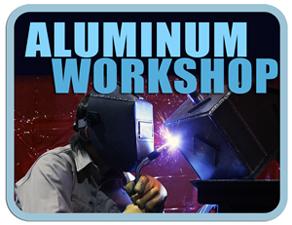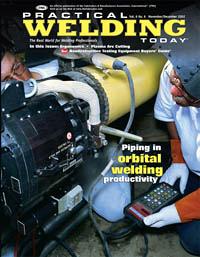President
- FMA
- The Fabricator
- FABTECH
- Canadian Metalworking
Categories
- Additive Manufacturing
- Aluminum Welding
- Arc Welding
- Assembly and Joining
- Automation and Robotics
- Bending and Forming
- Consumables
- Cutting and Weld Prep
- Electric Vehicles
- En Español
- Finishing
- Hydroforming
- Laser Cutting
- Laser Welding
- Machining
- Manufacturing Software
- Materials Handling
- Metals/Materials
- Oxyfuel Cutting
- Plasma Cutting
- Power Tools
- Punching and Other Holemaking
- Roll Forming
- Safety
- Sawing
- Shearing
- Shop Management
- Testing and Measuring
- Tube and Pipe Fabrication
- Tube and Pipe Production
- Waterjet Cutting
Industry Directory
Webcasts
Podcasts
FAB 40
Advertise
Subscribe
Account Login
Search
Aluminum Workshop: Welding Extruded Aluminum
- By Frank Armao
- Updated August 8, 2023
- January 6, 2015
- Article
- Aluminum Welding
Q: I bought anodized 6061-T6 extruded tubing and have been trying to gas tungsten arc weld (GTAW) if, but the results so far haven’t been satisfactory. The welds look black and porous. I’m an experienced welder, and I’ve welded aluminum before, but I’ve never run into this. Is there something wrong with my power supply? Do I need a different shielding gas? Help!
A: No, you probably aren’t doing anything wrong. This is a common problem caused by the anodized coating.
It might help you solve your problem to understand better what anodizing is and how the coating is produced. Then you’ll be able to see why you’re getting welds that aren’t up to your quality standards.
An electrolytic process similar to plating produces anodized coatings. The piece to be anodized is put in a bath containing the proper chemicals—usually a combination of acids—and connected to an electrical power supply.
Another electrode is in the bath. Current flows from the power supply through the electrode, through the chemical bath, through the aluminum part being anodized, and back to the power supply.
In plating processes, the part being plated is connected to the negative terminal of the power supply (the cathode), and a metallic element is plated onto the surface of the part.
The chemicals used in a plating bath are different from those used in anodizing.
In the anodizing process, the aluminum part is connected to the positive lead (the anode), and aluminum oxide is deposited onto the surface of the part. The thickness of the aluminum oxide coating formed depends on a number of factors, such as the time in the bath, the current, and the chemical composition of the bath.
As an aside, small aluminum parts can be anodized at home using only a minimum amount of equipment. A description of how to do this is too long to give here, but you can find a number of articles on the Internet by searching for “anodizing.”
Coatings in Welding Anodized Aluminum
So the anodized coating is actually a thick, clear coating of aluminum oxide. How thick? To put it in perspective, clean aluminum has an oxide coating of 30 to 50 angstroms. Anodized coatings usually are thicker than 1,000 angstroms.
But wait a minute—I said “clear,” didn’t I? That’s right. Most of us think of anodized coatings as being bright blue, red, or other colors, because that’s what we see on baseball bats and boat parts, for instance.
However, the anodizing actually is clear. The coating is porous, though, so it readily absorbs organic dyes. When you see a brightly colored anodized part, it’s actually the dye that gives it the color. The aluminum oxide coating is hard and doesn’t wear off quickly, so the color lasts a long time.
Why should the anodized coating cause problems in welding?
First, aluminum oxide is an electrical insulator. If the anodizing is thick enough, you won’t be able to strike an arc on it at all.
More commonly, the anodizing isn’t thick enough to block the flow of electrons completely. It partially blocks the current flow, though, so the arc is fluttery and unstable. Even the arc cleaning you get with AC GTAW can’t remove it completely, so the arc looks different.
Second, the oxide coating is porous and absorbs water vapor from the air. When you weld over the coating, the water vapor is released into the arc, causing porosity in the weld. This causes internal weld porosity. The aluminum oxide from the anodized coating often floats to the surface of the weld, giving it a gritty, rough appearance.
Unfortunately, no quick fix is available for these problems other than to remove the anodized coating from the weld area before welding. Some welders claim success with using various types of specialized tungsten electrodes or specialized power supplies that generate a sawtooth-shaped wave rather than a sine wave or square wave.
None of these are real solutions. They can’t attack the cause of the problem and are of very limited use in my experience.
The best solution is to remove the oxide coating either chemically or mechanically before welding. Chemical solutions must be aggressive and can be dangerous to work with.
For most fabricators, it’s better to remove the anodizing mechanically. Removal can be performed easily using a die or angle grinder and a medium- or fine-grit sanding disk. It can remove the oxide coating quickly.
You don’t have to remove much material; it’s necessary only to shine the surface. Don’t try to remove the coating with a wire brush because it won’t remove the anodizing but only polish it.
Q: I’ve been told not to weld 7075 series aluminum. I would really like to use it in an upcoming fabrication, but I’m somewhat concerned. What should I do?
A: By all means, avoid welding 7075 series aluminum. You need to remember that some aluminum alloys are just not arc-weldable. This is one of those alloys.
Another common aluminum alloy that falls into this category is 2024. Neither of these alloys was designed to be arc-weldable.
In general, alloys in the 2XXX and 7XXX series are not arc-weldable, although they can be joined using other, specialized welding processes. Exceptions to this rule are alloys 2014, 2219, 2519, 7003, 7005, 7027, and 7039. Most of the other alloys in these families are unweldable. By “unweldable” I don’t mean you can’t fuse them together; in fact, you can, and the weld will look perfectly acceptable.
The problem is that, because of the chemistry of these welds, they are prone to form microcracks in the weld and heat-affected zone. So while the weld appears visually acceptable, it likely will fail in service.
The real difficulty is that both 7075 and 2024 are strong and commonly available. You can consult a catalog from a service center and find one or both of these alloys. You may be tempted to use them because of their high yield and tensile strengths, but avoid the temptation if you plan to weld.
About the Author

Frank Armao
Aluminum Consulting Inc.
440-479-0239
About the Publication
Related Companies
subscribe now

The Welder, formerly known as Practical Welding Today, is a showcase of the real people who make the products we use and work with every day. This magazine has served the welding community in North America well for more than 20 years.
start your free subscription- Stay connected from anywhere

Easily access valuable industry resources now with full access to the digital edition of The Fabricator.

Easily access valuable industry resources now with full access to the digital edition of The Welder.

Easily access valuable industry resources now with full access to the digital edition of The Tube and Pipe Journal.
- Podcasting
- Podcast:
- The Fabricator Podcast
- Published:
- 04/16/2024
- Running Time:
- 63:29
In this episode of The Fabricator Podcast, Caleb Chamberlain, co-founder and CEO of OSH Cut, discusses his company’s...
- Trending Articles
Sheffield Forgemasters makes global leap in welding technology

ESAB unveils Texas facility renovation

Engine-driven welding machines include integrated air compressors

The impact of sine and square waves in aluminum AC welding, Part I

How welders can stay safe during grinding

- Industry Events
16th Annual Safety Conference
- April 30 - May 1, 2024
- Elgin,
Pipe and Tube Conference
- May 21 - 22, 2024
- Omaha, NE
World-Class Roll Forming Workshop
- June 5 - 6, 2024
- Louisville, KY
Advanced Laser Application Workshop
- June 25 - 27, 2024
- Novi, MI



























